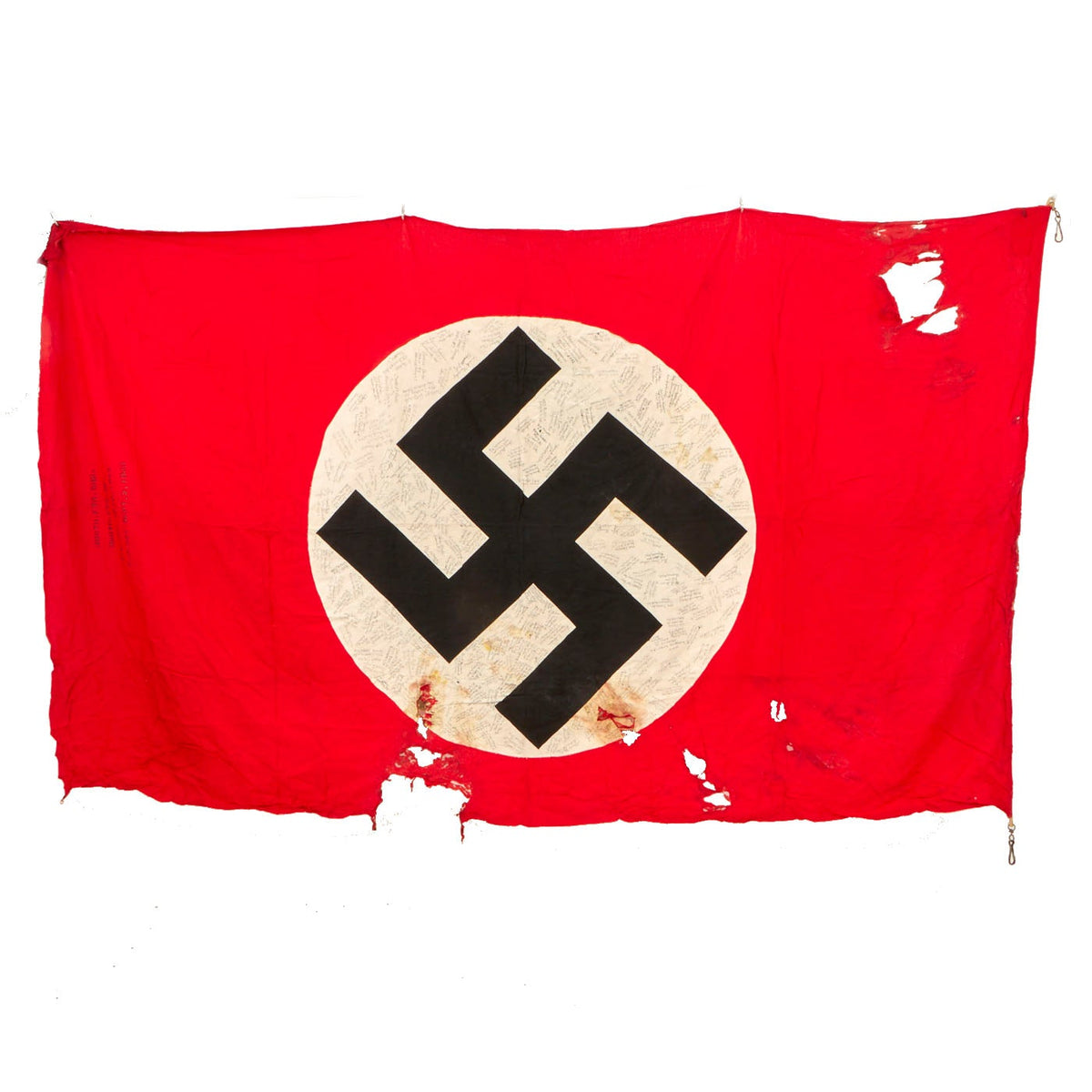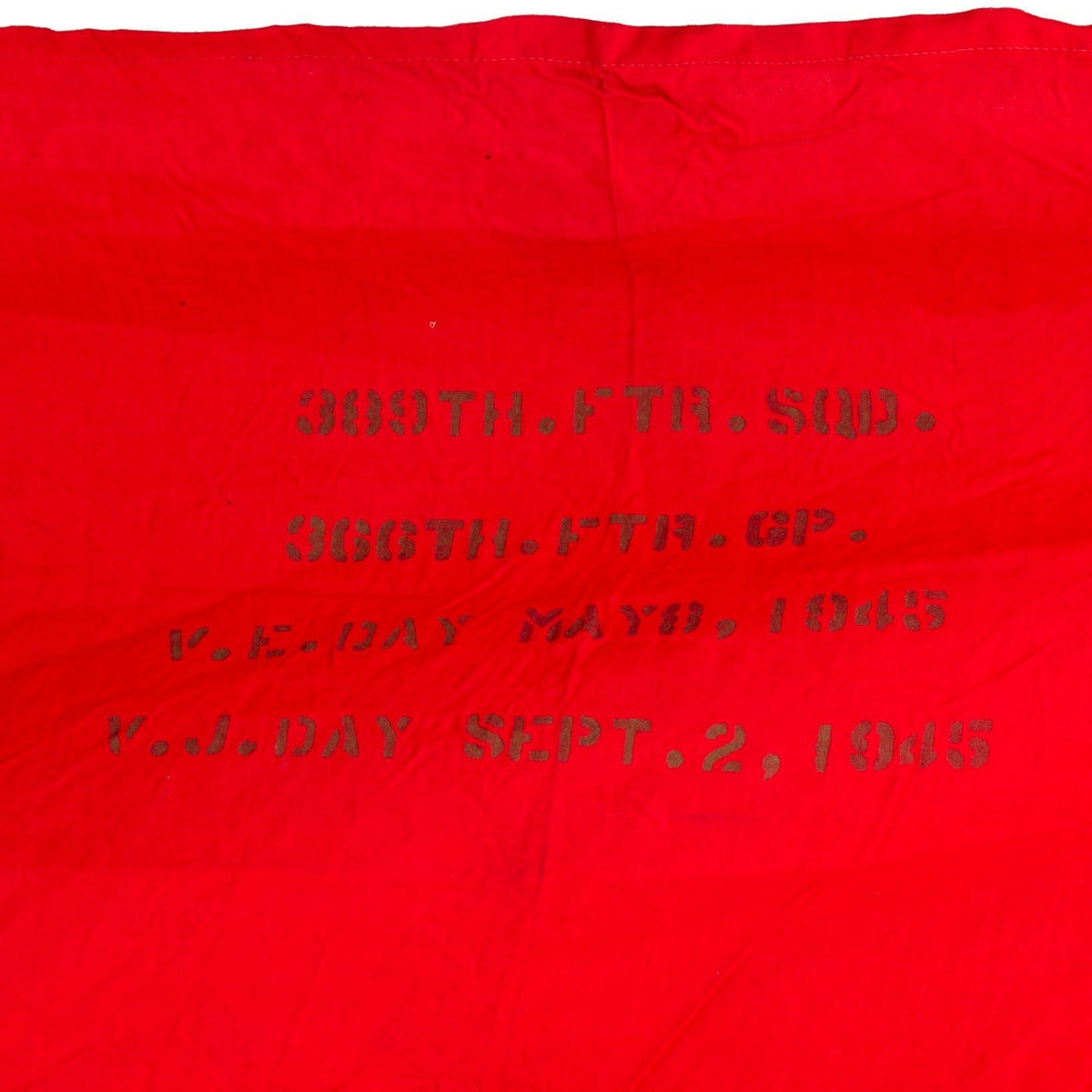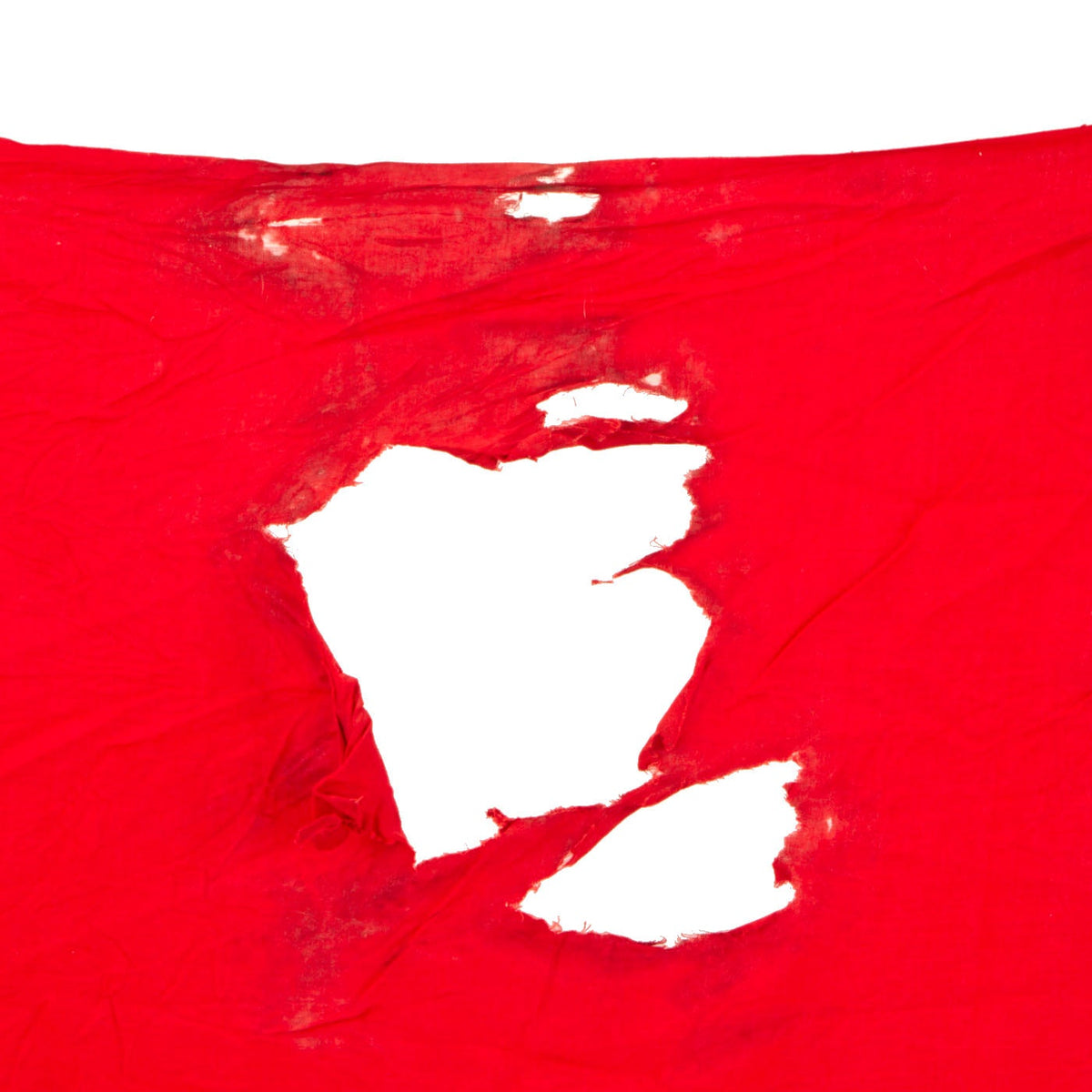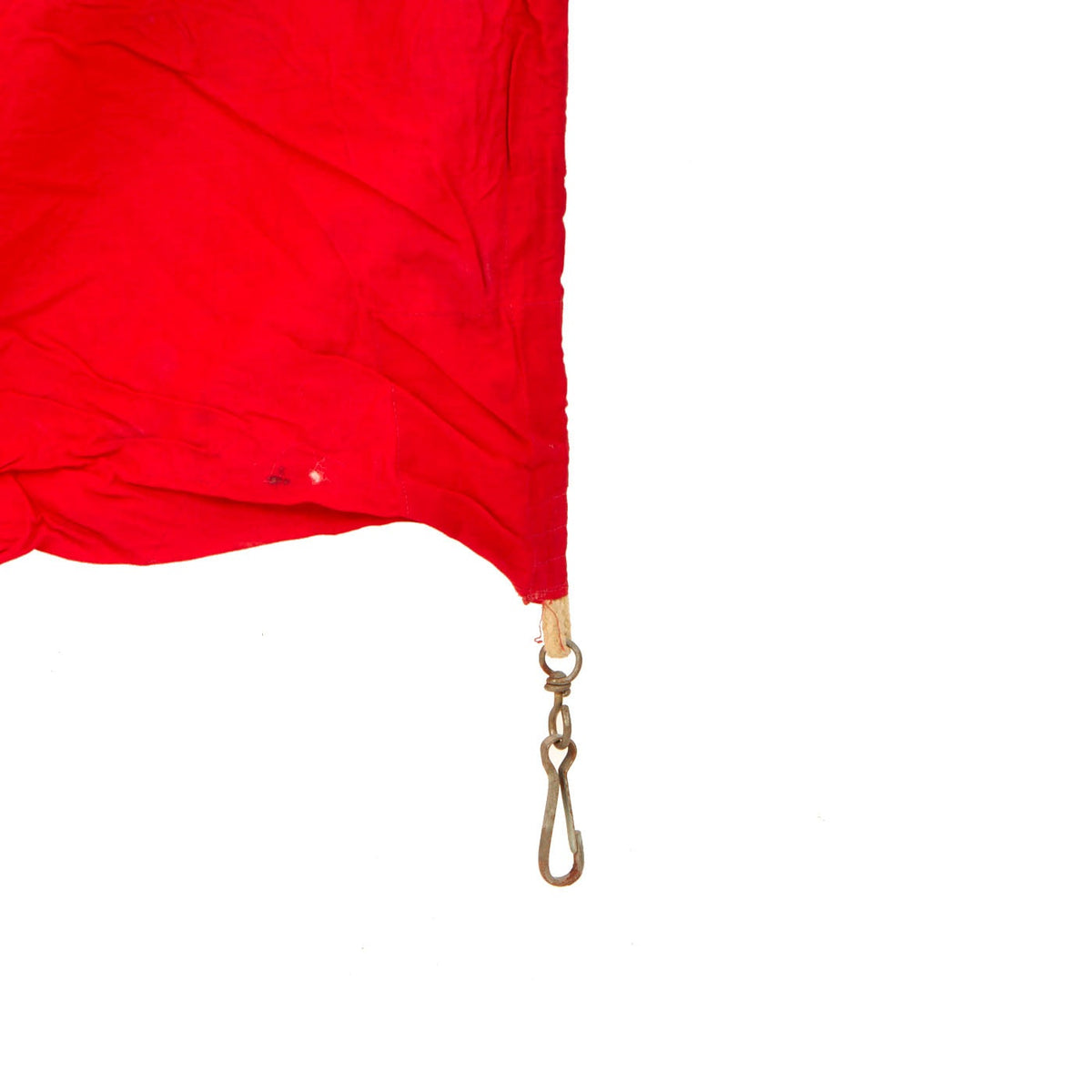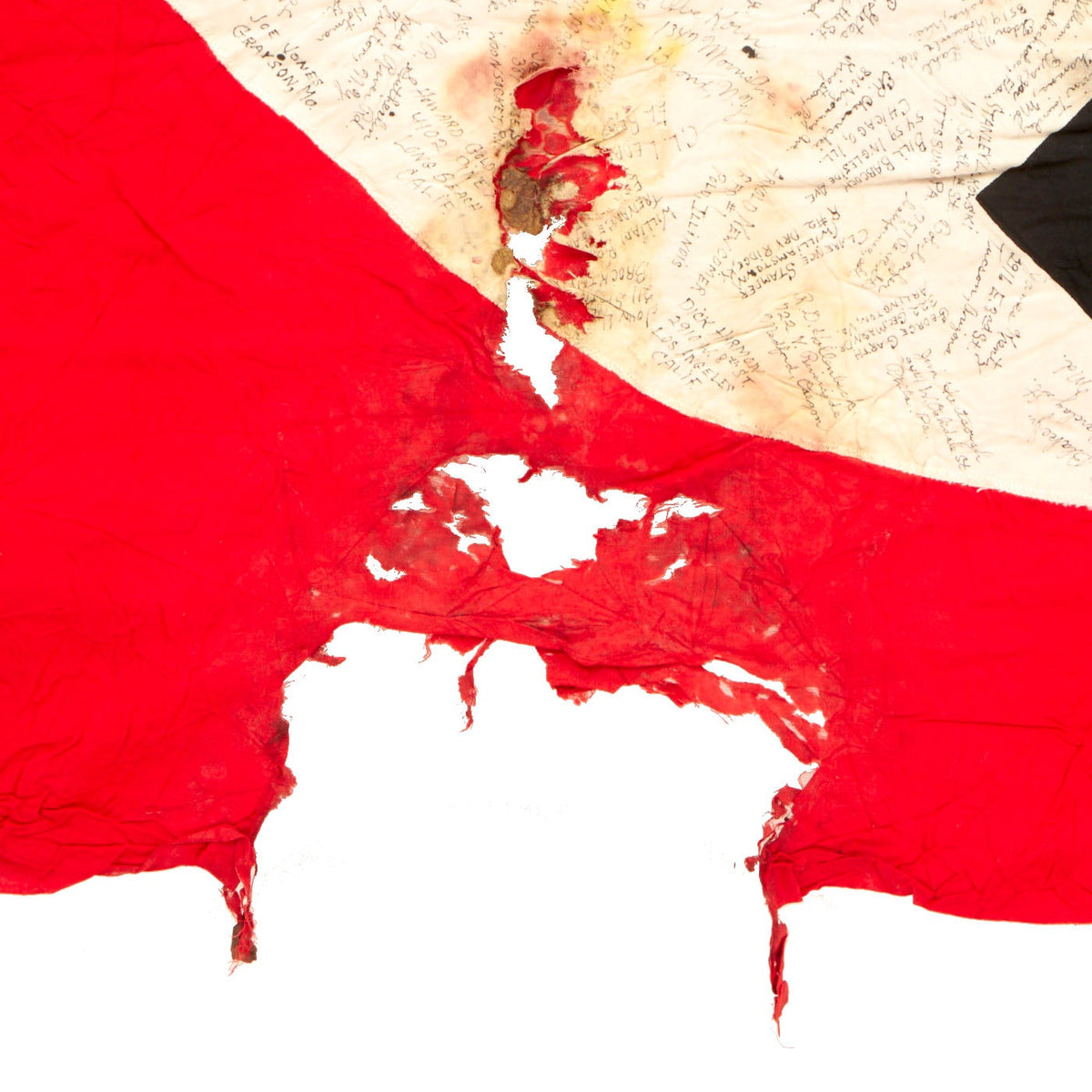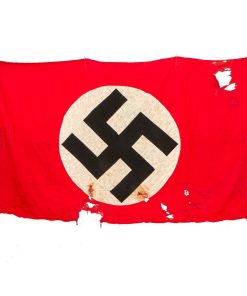Original German WWII Captured National Flag Signed by U.S. 389th Fighter Squadron & 366th Fighter Group – Ralph C. Grause Lot Original Items
$ 1.695,00 $ 423,75
Original Items: Only One Group Available. This is a very nice grouping brought home by a Ralph C. Grause after WWII. All we have been able to find out about Grause is that he was born in 1919 in Ohio and he enlisted on December 19, 1942 in the Army.
The NSDAP flag measures 53” x 92” and does have some damage to it, whether it was damaged during the war or afterwards. The flag was signed by the men of the 389th Fighter Squadron & The 366th Fighter Group. There are at least 100 names, possibly more, with their hometowns beneath their names. All of the writing can be found in the white center circle surrounding the swas. There is a stenciled description/unit names on the red portion of the flag.
The marking is as follows:
389TH.FTR.SQD.
366TH.FTR.GP.
V.E.DAY MAY8, 1945
V.J. DAY SEPT.2, 1945
Also included in this group is:
-Kriegsmarine Pharmacist Patch in white
-Kriegsmarine Medical NCO Patch
-Kriegsmarine Navigator Patch
-American 9th Air Forces Patch
-American Europe Communications Zone Patch
-American Army Air Forces Armament Specialist Sleeve Insignia
-American Moore Missileer Membership Pin for 1959: “All American Legionnaires who enroll 15 of the 1959 memberships by The American Legion’s 40th anniversary this March 15 will be entitled to a ‘Moore Missileer’ pin in recognition of their efforts to get 1959 membership into orbit.” It’s an American Legion award for enrolling 15 or more members in the Legion in 1959.
-”America’s Hero” Gen. MacARTHUR Pin with ribbon and Army Air Forces Pendant
-American 370th Bombardment Squadron Pin: The pin is small, measures 6/8” inch in diameter. The emblem of the 370th Bombardment Squadron is one of a set of military insignia pins issued by Kellogg’s with their PEP cereal in 1943. The set is known as the “Pep War Insignia Pins” and features 36 WWII military squadron emblems. It was created for Kellogg’s by the legendary “Premium King” Sam Gold. Kellogg’s Pep cereal brand-sponsored radio programs gave away premium items such as trading cards, badges, and pinback buttons.
-American Ribbon Bar and Insignia: Ribbons include American Campaign, EAME Campaign with 2 stars, Army Good Conduct and an Army Presidential Unit Citation. Insignia includes a Marksmanship badge for the rifle and a “US” collar disc.
-American Army Shoulder Cord in Yellow
-”Souvenir De Lausanne-Ouchy: This small packet of photos contains pictures of various locations surrounding the Alps
-”Souvenir of a Leave in Brussels, 1945” Pictures: 6 postcard style photos
-11 Photos: Various photos in different size, some of Ralph Grause and other soldiers
This is a very nice grouping attributed to an American soldier who fought in WWII and has endless research possibilities due to all the signatures that can be found on the NSDAP flag!
389th Fighter Squadron
The 389th flew combat in the European Theater of Operations from 14 March 1943 to 3 May 1945. Lt. Col. John B. England, who was commander of the 389th Fighter-Bomber Squadron from Alexandria AFB, was killed when his F-86 crashed into the woods near Toul. He was returning from gunnery practice near Tripoli, Libya. The fog was very thick and visibility was near zero. After several attempts to locate the runway his plane suffered fuel starvation. At this moment he sighted a portion of the runway and was in a glide with a high probability of a successful landing. But his glide path took him over the barracks where his men were housed. He calmly stated on the radio that this was not an acceptable risk. He turned and crashed into a wooded area outside the base perimeter. In his honor, Alexandria AFB was renamed England Air Force Base, and retained that name until its closure in 1993.
366th Fighter Group
The Group moved in England over the New Year of 1944, setting up home first at Membury and then at Thruxton. The pilots’ first mission was a fighter sweep of the French coast in March 1944 and from then until D-Day that June the ground supported Allied preparations for the invasion of France, taking out German military sites and equipment in northern France. The Group were awarded a DUC for quite a singular action: when supporting infantry in the St. Lo area on 11 July 1944, the pilots discovered a column of enemy tanks as yet unknown to the infantry. Despite coming under intense fire, the Group, as well as striking nearby pillboxes, the intended target of the mission, attacked this column. This put many of the German tanks out of action before they engaged the infantry. The Group carried out armed reconnaissance missions during the Battle of the Bulge (December 1944-January 1945) and escorted bombers during the assult across the Rhine river. The Group’s last mission saw them attacking harbors at Kiel and Flensburg on 3 May 1945. The Group remained in Germany after the war and, as part of United States Air Forces in Europe (USAFE), were part of the occupation force.
Fast Shipping with Professional Packaging
Thanks to our longstanding association with UPS FedEx DHL, and other major international carriers, we are able to provide a range of shipping options. Our warehouse staff is expertly trained and will wrap your products according to our exact and precise specifications. Prior to shipping, your goods will be thoroughly examined and securely secured. We ship to thousands clients each day across multiple countries. This shows how we're dedicated to be the largest retailer on the internet. Warehouses and distribution centres can be located throughout Europe as well as the USA.
Note: Orders with more than one item will be assigned a processing date depending on the item.
Before shipping before shipping, we'll conduct a thorough inspection of the items you have ordered. Today, the majority of orders will be delivered within 48 hours. The delivery time will be between 3-7 days.
Returns
The stock is dynamic and we cannot completely manage it because multiple stakeholders are involved, including our factory and warehouse. So the actual stock may alter at any time. It's possible that you may not receive your order once the order has been made.
Our policy is valid for a period of 30 days. If you don't receive the product within 30 days, we are not able to issue a refund or an exchange.
You can only return an item if it is unused and in the same state as the day you received it. You must have the item in its original packaging.
Related products
Uncategorized
Band of Brothers ORIGINAL GERMAN WWII Le. F.H. 18 10.5cm ARTILLERY PIECE Original Items
Uncategorized
Armoured Fighting Vehicles of the World: AFVs of World War One (Hardcover Book) New Made Items
Uncategorized
Australian WWII Owen MK1 Machine Carbine SMG Custom Fabricated Replica with Sling Original Items
Uncategorized
Uncategorized
Uncategorized
Uncategorized
Uncategorized
Uncategorized
Uncategorized
Uncategorized
Uncategorized
Uncategorized
Uncategorized
Uncategorized
Uncategorized
Uncategorized
Armored Burgonet Helmet & Polearm from Scottish Castle Leith Hall Circa 1700 Original Items
Uncategorized
